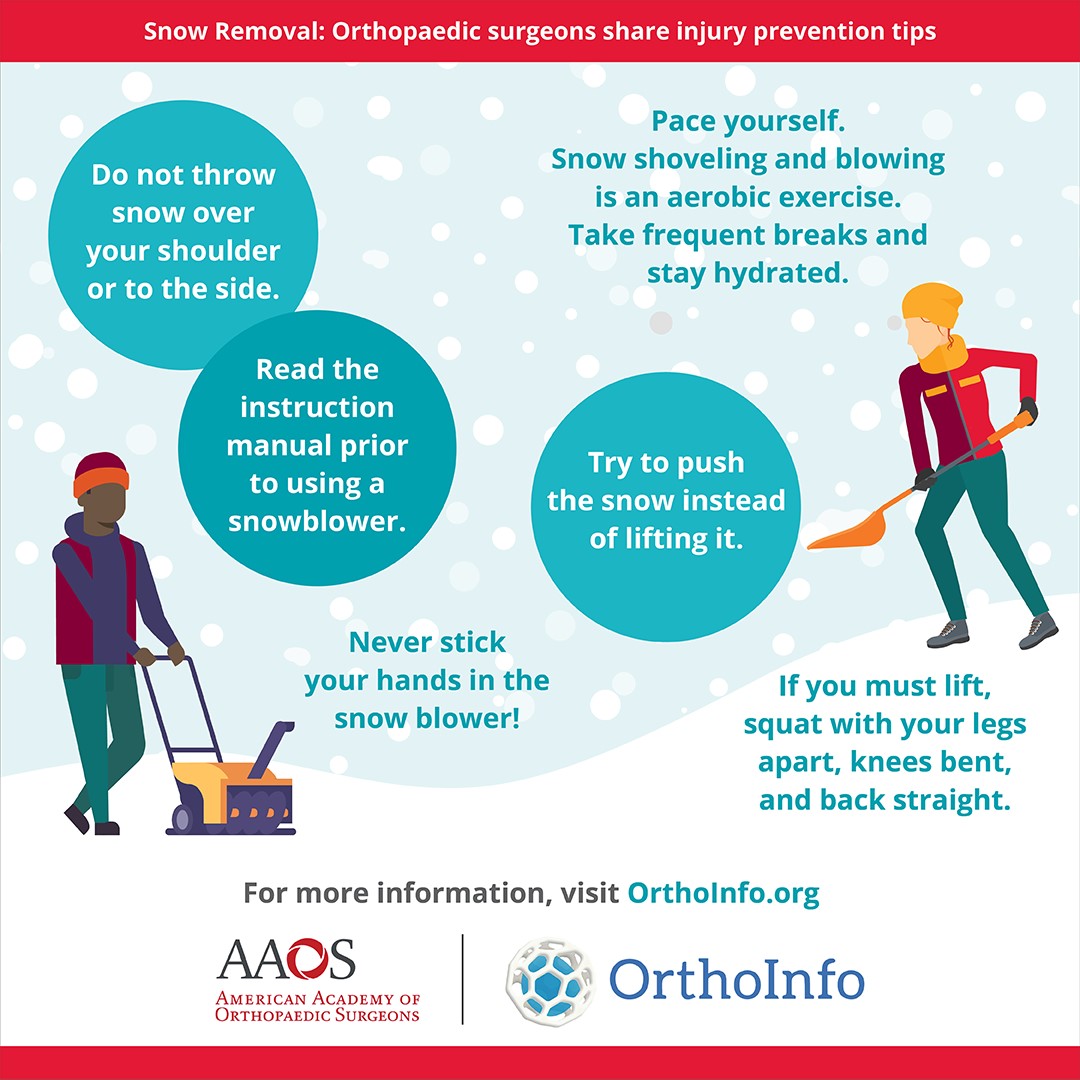
ROSEMONT, Ill. (November 25, 2019) — While 2019 predictions call for warmer-than-average temperatures this winter for much of the United States[1], the risk of injury from snow and ice remains the same. Cold-weather conditions bring hazards that can be downright dangerous for those trying to clear walkways, paths and other areas. The American Academy of Orthopaedic Surgeons (AAOS) is urging all those involved in snow removal and winter-weather cleanup to take precautions and focus on safety.
“Lifting heavy snow or chipping away at ice is a strenuous activity that puts your back at risk for serious strain or injury,” states Alan S. Hilibrand, MD, FAAOS, orthopaedic surgeon who specializes in spine and a spokesperson for the AAOS. “Sprains and strains of the shoulder and back are most common, especially if exercise is not part of your regular routine. Before beginning, warm up your muscles for 10 minutes with light exercise or activity. And beware trying to shovel heavy wet snow.”
In 2018, more than 137,598 snow blowing and shoveling-related injuries were treated in emergency departments, doctors’ offices and clinics, according to the Consumer Product Safety Commission (CPSC). To help reduce snow removal injuries this winter, consider the following tips from the orthopaedic surgeons at the AAOS:
Tips before you begin:
- Dress appropriately. Light layered, water-repellent clothing provides both ventilation and insulation. Wear appropriate head covering and thick, warm socks. Choose gloves or mittens that will keep your hands warm, dry, and blister-free. Avoid falls by wearing shoes or boots that have slip-resistant soles.
- Start early. Try to clear snow early and often to avoid moving heavy, packed snow.
- Make sure you can see. Watch for ice patches and uneven surfaces. Do not let a hat or scarf block your vision. Be sure that you can fully see the area that you are clearing.
- Check with your doctor if you have any medical problems. Clearing snow places a great deal of stress on the heart, so if you have a medical condition or do not exercise regularly, talk with your doctor about the proper precautions. You may also want to consider hiring someone to remove the snow, rather than doing it yourself.
Tips for snow shoveling:
- Pace yourself. Snow shoveling and snow blowing are aerobic activities. Take frequent breaks and prevent dehydration by drinking plenty of fluids. If you experience chest pain, shortness of breath, or other signs of a heart attack, stop the activity and seek emergency care.
- Proper equipment. Use a shovel that is comfortable for your height and strength. Do not use a shovel that is too heavy or too long for you. Space your hands on the tool grip to increase your leverage.
- Proper lifting. Try to push the snow instead of lifting it. If you must lift, do it properly. Squat with your legs apart, knees bent, and back straight. Lift with your legs. Do not bend at the waist. Scoop small amounts of snow into the shovel and walk to where you want to dump it. Holding a shovelful of snow with your arms outstretched puts too much weight on your spine. Never remove large amounts of snow all at once – this is particularly important in the case of heavy, wet snow. Do it in steps, taking caution to not throw it over your shoulder or to the side. This requires a twisting motion that stresses your back.
Tips for snow blowing:
- Understand your machine.Read the instruction manual prior to using a snowblower. Be familiar with the specific safety hazards and unfamiliar features. Do not attempt to repair or maintain the snowblower without reading the instruction manual.
- Never stick your hands in the snowblower! If snow jams the snowblower, stop the engine and wait more than five seconds. Use a solid object to clear wet snow or debris from the chute. Beware of the recoil of the motor and blades after the machine has been turned off.
- Proper supervision. Do not leave the snow blower unattended when it is running. Shut off the engine if you must walk away from the machine.
- Safe fueling. Add fuel before starting the snowblower. Never add fuel when the engine is running or hot. Be sure to always fuel your snowblower outside rather than in a garage, shed, or enclosed area to avoid being overwhelmed by engine fumes. Never operate the machine in an enclosed area.
- Watch the snowblower cord.If you are operating an electric snow blower, be aware of where the power cord is at all times. If the cord becomes caught in the machine and is severed, or comes in contact with the engine and burns, you could receive a shock or become electrocuted.
- Be cautious of motor recoil.Beware of the brief recoil of motor and blades that occurs after the machine has been turned off.
To read more about winter weather safety and injury prevention, visit OrthoInfo.org.
With more than 39,000 members, the American Academy of Orthopaedic Surgeons is the world’s largest medical association of musculoskeletal specialists. The AAOS is the trusted leader in advancing musculoskeletal health. It provides the highest quality, most comprehensive education to help orthopaedic surgeons and allied health professionals at every career level best treat patients in their daily practices. The AAOS is the source for information on bone and joint conditions, treatments and related musculoskeletal health care issues and it leads the health care discussion on advancing quality.
[1] National Oceanic and Atmospheric Administration, 2019, https://www.noaa.gov/media-release/winter-outlook-warmer-than-average-for-many-wetter-in-north
Contact AAOS Media Relations
Deanna Killackey
847-384-4035
killackey@aaos.org
Lauren Riley
847-384-4031
pearson@aaos.org